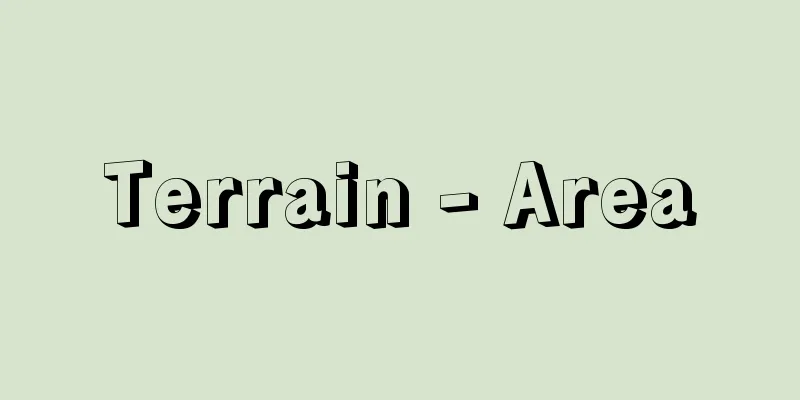Terrain - Area

|
The undulating form of the Earth's crustal surface, which is the boundary between the Earth's atmosphere, hydrosphere, and lithosphere (rock sphere). The Earth's crustal surface ranges from Mount Everest, which is 8,848 meters high, to the Challenger Deep, which is 10,920 meters deep, with an elevation difference of approximately 20,000 meters. The topography that is above sea level is called terrestrial topography, and the topography that is below sea level is called submarine topography. The formation of landforms is related to the properties of rocks and geological structures, collectively known as textures, as well as the process of landform development due to forces acting on the surface of the Earth's crust and gravity, known as geomorphic processes, the time involved in which geomorphic processes change over time and in different regions, and the stages that indicate the developmental stages of landforms. These are considered to be the topographical factors that govern landforms. Among these geomorphic processes, those that have their origins within the Earth, such as ground movement and volcanic activity that create unevenness on the Earth's surface, are called internal forces, while dynamic processes that originate from solar energy, such as running water, groundwater, waves, tides, wind, and glaciers that transport debris, are called external forces or erosion processes. Gravity is distinguished from other processes, as it is merely a directional force that moves material on the surface of the Earth's crust downward. The downward movement of mass material due to gravity, such as landslides, debris avalanches, and soil creep, is called mass movement. The geometric characteristics of a terrain, such as elevation, relief, gradient, slope, scale, arrangement, etc., are called topographical elements. In the study of topography, topography is viewed as a collection of topographical elements, which are then analyzed genetically as a function of topographical factors, and the causes, formation mechanisms, and development processes of the terrain are considered. In geomorphology, rather than everyday terms based on empirical classifications such as naturally occurring mountains, plateaus, hills, plateaus, and plains, which are based on topographical factors, topographical terms based on genetic classifications such as fault mountains, volcanic areas, old mountains, Tertiary hills, erosional plateaus, diluvial plateaus, and alluvial plains are used. [Shingo Juen] Classification of terrainLandforms formed by internal processes such as crustal movement and volcanic activity are called large landforms or structural landforms. Examples include volcanic landforms, folded landforms, and fault landforms. However, the term structural landforms also includes erosional landforms that reflect geological structures and are formed due to differences in the resistance of rocks to denudation and erosion. To distinguish between these, landforms created primarily by crustal movement are called tectonic landforms, and erosional landforms that reflect geological structures are called textured landforms. Examples of tectonic landforms include fault scarps, lateral displacements of mountain ridges and valleys, landslides, and grabens caused by fault movement, anticline ridges and syncline valleys caused by folding, and uplifted mountains (mountains formed by the gentle upward bending of the earth's crust) and uplifted basins caused by bending. Examples of organized landforms include cuestas, hogbacks (monoclinic ridges with approximately equal slopes on both sides in cross section that develop in areas with a monoclinic structure consisting of hard and soft alternating layers with a steep slope of 45 degrees or more), organized terraces, mesas, buttes, anticlinal valleys, synclinal ridges, and monoclinal ridges. Weathering, mass movement, erosion, and sedimentation are called external actions, and landforms formed by external actions are called small landforms or eroded landforms. In this case, eroded landforms also include landforms caused by sedimentation. Among eroded landforms, landforms formed by river action are called fluvial landforms or river valley landforms. Landforms formed by wave action are called wave-eroded landforms or coastal landforms. Landforms formed by glacial action are called glacial landforms, and landforms that develop in arid regions where wind action is dominant are called arid landforms or wind-eroded landforms. Furthermore, landforms that develop in limestone regions where groundwater erosion is dominant are called karst landforms or eroded landforms. Landslides, cliff collapses, debris avalanches, mudslides, and soil creep are typical landforms caused by mass movement. A landform formed by a single dominant geomorphic process is called a simple landform, whereas a landform in which two or more geomorphic processes play an important role in its development is called a complex landform. A landform formed during only one erosion cycle (geomorphic cycle) is called a single cycle landform, whereas a landform formed during two or more erosion cycles is called a multicycle landform. A landform formed in the past geological period, then buried under some kind of cover, and exposed in the more recent geological period when the cover was removed, is called a resurrected or excavated landform. Relics of past (pre-cycle) landforms are called relics, and are often used to refer to landforms that developed under different climatic conditions than today and by geomorphic processes that are no longer active today. A landform that was buried under sediments is called a fossil landform. This can refer to a buried landform or an excavated landform that has been dug up by erosion and appears on the surface almost exactly as it was before it was buried. In terms of the scale of topography, the overall shape of the solid earth, the shapes of the continents, and the shapes of the ocean basins are called first-order topography, plains, plateaus, mountain ranges, and ocean trenches are called second-order topography, and valleys, ridges, banks, peaks, watersheds, alluvial fans, etc. are called third-order topography. Also, on 1:50,000 and 1:25,000 topographic maps, slight highs and lows that are not clearly shown are called microtopography. [Shingo Juen] "New Edition of Japanese Geomorphology" by Yoshikawa Torao (1973, University of Tokyo Press)" ▽ "Volcanic Activity and Geomorphology, with a Focus on Tohoku Volcanoes" by Murayama Iwa (1973, Daimeido)" ▽ "River Geomorphology" by Takayama Shigemi (1974, Kyoritsu Shuppan)" ▽ "Exploring Geomorphology" by Kaneko Shiro (1976, Kokin Shoin)" ▽ "Geography" by Herbert Wilhelmy, translated by Tanioka Takeo and Kitano Yoshinori, 2 volumes (1978, 1979, Chijin Shobo)" ▽ "Climatic Geomorphology" by J. Budel, translated by Hirakawa Kazuomi (1985, Kokin Shoin)" ▽ "Introduction to Geomorphology for Engineers" edited by Kumaki Yota et al. (1995, Sankaido)" ▽ "Modern Geomorphology" by Richard J. Chorley, translated by Ouchi Shunji (1995, Kokon Shoin)" ▽ "Top 10 Geographies of the World: Various Topographies and Various Lives" by Neil Morris, translated by Egawa Takio, 8 volumes in total (1999, Suzuki Publishing)" ▽ "Exploring Tectonic Landforms" by Ota Yoko, 2 volumes in total (1999, Kokon Shoin)" ▽ "Interpreting Active Faults from Microtopography" by Togo Masami (2000, Kokon Shoin)" ▽ "Japanese Geomorphology 1: Overview" edited by Yonekura Nobuyuki, Kaizuka Sohei, Nogami Michio, and Chinzei Kiyotaka (2001, University of Tokyo Press)" ▽ "Comparative Tectonic Landforms: Topography of Plate Boundaries and Quaternary Crustal Movement" by Uemura Yoshihiro (2001, Kokon Shoin)" ▽ "Japan's Topography and Geology - For the Safe Management of the Nation's Land, edited by the National Federation of Geological Survey Associations (2001, Kajima Publishing Co., Ltd.)" ▽ "Ikeda Hiroshi, An Eye for Topography (2001, Kokin Shoin)" ▽ "Koizumi Takehide and Aoki Masato, edited by Japan's Topography Red Data Book Volume 2: Topography that Should be Preserved (2002, Kokin Shoin)" ▽ "Kaizuka Sohei, Japan's Topography: Characteristics and Origins (Iwanami Shinsho)" [References] | | | | | | | | | | | | | | | | | | | | | | | | | | | |fault | | | | | | | | | | | | |Source: Shogakukan Encyclopedia Nipponica About Encyclopedia Nipponica Information | Legend |
|
地球の気圏や水圏とリソスフェア(岩石圏)との境界である地殻表面の起伏形態。地殻表面には高度8848メートルのエベレスト山から、水深1万0920メートルに達するチャレンジャー海淵(かいえん)まであり、その高度差は約2万メートルに及ぶ。このうち海水面上に出ている地形を陸上地形、海水面下にある地形を海底地形という。 地形の生成には、一括して組織とよばれる岩石の性質や地質構造のほか、地形プロセスとよばれる地殻表面に作用する営力や重力による地形の発達過程、また地域的にも時代的にも変化する地形プロセスが関与する時間、あるいは地形の発達段階を示す階梯(かいてい)などが関係し、これらが地形を支配する地形因子とされている。この地形営力のうち、地表面に凹凸を生ずる地盤運動や火山活動のように、地球の内部に力の根源をもつものは、内力とよばれ、岩屑(がんせつ)などを運搬する流水、地下水、波浪、潮流、風、氷河などのように太陽エネルギーを根源とする動的営力は外力または侵食営力とよばれる。重力は地殻表面物質を下方へ移動させる指向力にすぎないので、営力とは区別される。地すべり、岩屑雪崩(なだれ)、土壌匍行(ほこう)などのように、重力による下方への集団的物質移動をマスムーブメントmass movementという。 地形の幾何学的特徴を示す高度、起伏、勾配(こうばい)、斜面、規模、配置などを地形要素とよぶ。地形の研究は、地形を地形要素の集合としてとらえ、それを地形因子の関数とみて発生論的に分析し、地形の成因、形成機構、発達過程などを考察する。 地形学では地形要素に基づく自然発生的な山地、高原、丘陵、台地、平野などの経験的分類による日常用語よりも、地形因子に基づく断層山地、火山地、老年山地、第三紀丘陵、侵食台地、洪積台地、沖積平野などの成因的分類による地形用語が使用される。 [壽圓晋吾] 地形の分類地殻運動や火山活動などの内作用によって形成された地形を大地形または構造地形という。火山地形、褶曲(しゅうきょく)地形、断層地形などがこれにあたる。しかし構造地形の語は、岩石の削剥(さくはく)や侵食に対する抵抗性の違いに由来して形成された、地質構造を反映する侵食地形を含むので、これを区別するために、地殻運動によって一次的につくられた地形を変動地形とよび、地質構造を反映する侵食地形を組織地形とよんでいる。断層運動による断層崖(がい)、山の尾根や谷の横ずれ、地塁、地溝などや、褶曲運動による背斜山稜(はいしゃさんりょう)や向斜谷、曲動による曲隆山地(地殻が穏やかに上方にたわむ曲隆運動によりできた山地)や曲隆盆地などは変動地形の例である。ケスタ、ホッグバック(45度以上の急傾斜の硬軟互層からなる単斜構造の地域に発達した、横断面形にみる両斜面の傾斜がほぼ等しい同斜山稜)、組織段丘、メサ、ビュート、背斜谷、向斜山稜、同斜山稜などは、組織地形の例である。 風化、マスムーブメント、侵食、堆積(たいせき)などの作用を外作用といい、外作用で形成された地形を小地形または侵食地形という。この場合の侵食地形には堆積による地形もこれに含まれる。侵食地形のなかで、とくに河川の作用によって生ずる地形を河食地形または河谷地形とよぶ。波の作用によって生ずる地形を波食地形または海岸地形という。氷河の作用により生ずる地形を氷河地形、風の作用の卓越する乾燥地域に発達する地形を乾燥地形または風食地形とよぶ。また、地下水の溶食が卓越する石灰岩地域に発達する地形をカルスト地形または溶食地形という。地すべり、崖(がけ)崩れ、岩屑雪崩、土石流、土壌匍行などはマスムーブメントによる代表的な地形である。 単一の優勢な地形プロセスのつくった地形を単純地形、二つまたはそれ以上の地形プロセスが発達に重要な役割を果たしている地形を複合地形という。ただ1回の侵食輪廻(りんね)(地形輪廻)の間に形成された地形を単輪廻地形、2回またはそれ以上の侵食輪廻の間に形成された地形を多輪廻地形という。過去の地質時代に形成され、その後なんらかの被覆物の下に埋まり、さらに最近の地質時代に被覆物を除去されて露出した地形を復活地形あるいは発掘地形という。過去(前輪廻)の地形の遺物を遺物地形といい、とくに現在とは異なる気候条件のもとで、現在はもはや働いていない地形営力によって発達した地形の遺物をさすことが多い。堆積物の下に埋もれていた地形を化石地形という。これには、埋没地形をさす場合と、それが侵食によって掘り出され、埋もれる前とほぼ同じ地形が地表に現れたもの、すなわち発掘地形をさす場合とがある。 地形の規模からみて、全体としての固体地球の形、大陸の形、海洋盆の形などを第一オーダー(序列)の地形、平原、高原(台地)、山脈、海溝などを第二オーダーの地形、谷、尾根、岸、峰、流域、扇状地などを第三オーダーの地形ということもある。また5万分の1や2万5000分の1の地形図では、明確に表現されない微高地や微低地を微地形とよぶ。 [壽圓晋吾] 『吉川虎雄著『新編日本地形論』(1973・東京大学出版会)』▽『村山磐著『火山の活動と地形 東北の火山を中心として』(1973・大明堂)』▽『高山茂美著『河川地形』(1974・共立出版)』▽『金子史朗著『地形をさぐる』(1976・古今書院)』▽『ヘルベルト・ウィルヘルミー著、谷岡武雄・北野善憲訳『地形学』全2巻(1978、1979・地人書房)』▽『J・ビューデル著、平川一臣訳『気候地形学』(1985・古今書院)』▽『熊木洋太ほか編著『技術者のための地形学入門』(1995・山海堂)』▽『リチャード・J・チョーレー著、大内俊二訳『現代地形学』(1995・古今書院)』▽『ニール・モリス著、江川多喜雄訳『世界の地理トップ10 いろいろな地形・さまざまなくらし』全8冊(1999・鈴木出版)』▽『太田陽子著『変動地形を探る』全2冊(1999・古今書院)』▽『東郷正美著『微小地形による活断層判読』(2000・古今書院)』▽『米倉伸之・貝塚爽平・野上道雄・鎮西清高編『日本の地形1 総説』(2001・東京大学出版会)』▽『植村善博著『比較変動地形論――プレート境界域の地形と第四紀地殻変動』(2001・古今書院)』▽『全国地質調査業協会連合会編『日本の地形・地質――安全な国土のマネジメントのために』(2001・鹿島出版会)』▽『池田宏著『地形を見る目』(2001・古今書院)』▽『小泉武栄・青木賢人編『日本の地形レッドデータブック第2集 保存すべき地形』(2002・古今書院)』▽『貝塚爽平著『日本の地形 特質と由来』(岩波新書)』 [参照項目] | | | | | | | | | | | | | | | | | | | | | | | | | | | | | | | | | | | | | | | | |出典 小学館 日本大百科全書(ニッポニカ)日本大百科全書(ニッポニカ)について 情報 | 凡例 |
Recommend
Hitachi's Furyumono - Hitachi's Furyumono
Furyumono floats that appear at the festival (May ...
Vater-Pacini corpuscle
...It is also suitable for detecting coarse vibra...
Musa acuminata (English spelling) Musaacuminata
...The cultivated bananas are a diverse group of ...
book club edition
...A membership-based organization that distribut...
Ashoka (English spelling)
The third king of the Maurya dynasty in India (rei...
Hot thigh - hard
… [Japanese manufacturing history] The first ham ...
Mutsure Island
An island in the southwest of Yamaguchi Prefectur...
Crime of Assembling with a Weapon - Kyoukijunbishugozai
When two or more people gather together with the ...
Mawardi - Mawardi (English spelling) al-Māwardī
Islamic jurist. Born in Maward, Iran. A Sunni jur...
Age - Nenrei
Legally, age is calculated by counting from the d...
Wild type - wild type
A biological term. The standard phenotype of an or...
Castilian Fields
...His ideas about time became even clearer after...
Mineral processing - Senko
Processing ores that are composed of several mine...
Joruri Tales - Joruri Monogatari
A late medieval storybook. Also known as "Twe...
EXAFS - EXAFS
...X-ray fluorescence analysis is the same analyt...









